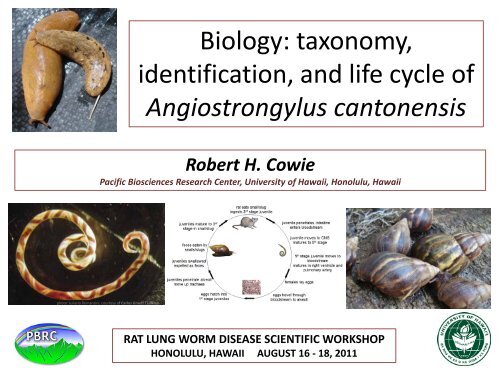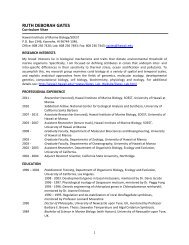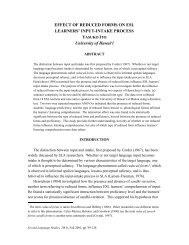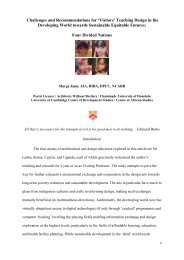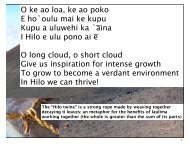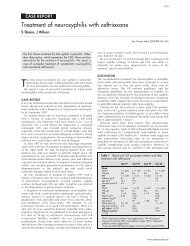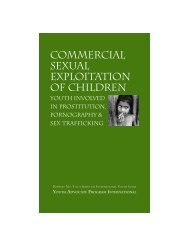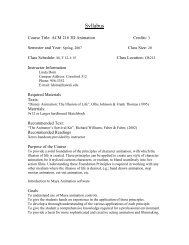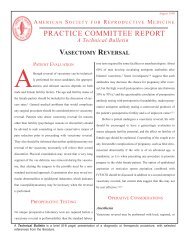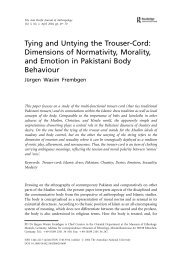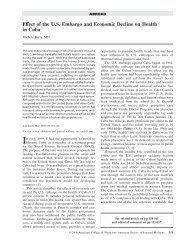taxonomy, identification, and life cycle of Angiostrongylus cantonensis
taxonomy, identification, and life cycle of Angiostrongylus cantonensis
taxonomy, identification, and life cycle of Angiostrongylus cantonensis
Create successful ePaper yourself
Turn your PDF publications into a flip-book with our unique Google optimized e-Paper software.
Biology: <strong>taxonomy</strong>,<br />
<strong>identification</strong>, <strong>and</strong> <strong>life</strong> <strong>cycle</strong> <strong>of</strong><br />
<strong>Angiostrongylus</strong> <strong>cantonensis</strong><br />
Robert H. Cowie<br />
Pacific Biosciences Research Center, University <strong>of</strong> Hawaii, Honolulu, Hawaii<br />
photo: Juliano Romanzini, courtesy <strong>of</strong> Carlos Graeff Teixeira<br />
RAT LUNG WORM DISEASE SCIENTIFIC WORKSHOP<br />
HONOLULU, HAWAII AUGUST 16 - 18, 2011
CLASSIFICATION AND DIVERSITY<br />
PHYLUM: Nematoda<br />
CLASS: Rhabditea<br />
ORDER: Strongylida<br />
SUPERFAMILY: Metastrongyloidea<br />
FAMILY: Angiostrongylidae<br />
• Around 19 species are recognized worldwide in the genus<br />
<strong>Angiostrongylus</strong><br />
• Two species infect humans widely:<br />
- <strong>Angiostrongylus</strong> costaricensis Morera & Céspedes, 1971<br />
causes abdominal angiostrongyliasis, especially a<br />
problem in South America<br />
- <strong>Angiostrongylus</strong> <strong>cantonensis</strong> (Chen, 1935)<br />
causes eosinophilic meningitis<br />
RAT LUNG WORM DISEASE SCIENTIFIC WORKSHOP<br />
HONOLULU, HAWAII AUGUST 16 - 18, 2011
NOMENCLATURE<br />
<strong>Angiostrongylus</strong> <strong>cantonensis</strong> (Chen, 1935)<br />
• First described by Chen (1935) as Pulmonema <strong>cantonensis</strong><br />
• Also described as Haemostrongylus ratti by Yokogawa (1937)<br />
• Pulmonema subsequently synonymized with <strong>Angiostrongylus</strong> <strong>and</strong> ratti with<br />
<strong>cantonensis</strong><br />
• <strong>Angiostrongylus</strong> <strong>cantonensis</strong> then widely accepted as the name <strong>of</strong> this species<br />
• Ubelaker (1986) split <strong>Angiostrongylus</strong> into five genera:<br />
<strong>Angiostrongylus</strong> (in carnivores), Parastrongylus (murids), Angiocaulus (mustelids),<br />
Gallegostrongylus (gerbils <strong>and</strong> one murid), Stefanskostrongylus (insectivores)<br />
• And placed <strong>cantonensis</strong> in the genus Parastrongylus<br />
• But this classification is not widely used <strong>and</strong> most people still refer to the species as<br />
<strong>Angiostrongylus</strong> <strong>cantonensis</strong><br />
RAT LUNG WORM DISEASE SCIENTIFIC WORKSHOP<br />
HONOLULU, HAWAII AUGUST 16 - 18, 2011
MORPHOLOGY, TAXOMOMY, IDENTIFICATION<br />
Adult males<br />
Caudal bursa<br />
Ubelaker, 1986<br />
1. <strong>Angiostrongylus</strong> vasorum<br />
2. Parastrongylus tateronae<br />
3. Angiocaulus gubernaculatus<br />
4. Rodentocaulus ondatrae<br />
5. Gallegostrongylus ibicensis<br />
Maldonado et al. 2010<br />
<strong>Angiostrongylus</strong> <strong>cantonensis</strong> – 3 locations in Brazil<br />
RAT LUNG WORM DISEASE SCIENTIFIC WORKSHOP<br />
HONOLULU, HAWAII AUGUST 16 - 18, 2011
MORPHOLOGY, TAXONOMY, IDENTIFICATION<br />
ADULT SIZE<br />
• Female: 17-34 mm long, 0.28-0.56 mm wide<br />
• Male: 15-25 mm long, 0.25-0.42 mm wide<br />
Ash, 1970<br />
1. <strong>Angiostrongylus</strong> <strong>cantonensis</strong><br />
2. Aleurostronglus abstrusus<br />
3. <strong>Angiostrongylus</strong> vasorum<br />
4. Anafilaroides rostratus<br />
RAT LUNG WORM DISEASE SCIENTIFIC WORKSHOP<br />
HONOLULU, HAWAII AUGUST 16 - 18, 2011<br />
Juliano Romanzini, courtesy <strong>of</strong> Carlos Graeff Teixeira<br />
Adult female with characteristic<br />
red (gut) <strong>and</strong> white (uterine<br />
tubules) spiral appearance<br />
3 rd STAGE SIZE (in snails/slugs)<br />
• 425-524 μm long, 23-34 μm wide<br />
IDENTIFICATION - 3 RD STAGE WORMS<br />
• size<br />
• pointed tail with no transverse striations
LIGHT MICROSCOPY OF 3 RD STAGE<br />
ANGIOSTRONGYLUS CANTONENSIS<br />
1a. Anterior end showing knob-like tips<br />
(KT), rod-like structure (RS),<br />
esophagus (E) <strong>and</strong> excretory pore (EP)<br />
1b. Posterior end showing tail pointed<br />
tip (TPT) <strong>and</strong> anus (A)<br />
Thiengo et al. 2010. Acta Tropica<br />
RAT LUNG WORM DISEASE SCIENTIFIC WORKSHOP<br />
HONOLULU, HAWAII AUGUST 16 - 18, 2011
• Definitive host – rats (various species)<br />
• Intermediate host – snails/slugs (various species)<br />
worms mature to 3 rd<br />
stage in snail/slug<br />
feces eaten by<br />
snails/slugs<br />
worms swallowed<br />
expelled as feces<br />
worms penetrate alveoli<br />
move up trachaea<br />
eggs hatch into<br />
1 st stage worms<br />
LIFE-CYCLE<br />
rat eats snail/slug<br />
ingests 3 rd stage worm<br />
worm penetrates intestine<br />
enters bloodstream<br />
worm moves to CNS<br />
matures to 5 th stage – young<br />
adult<br />
young adult worm moves to<br />
bloodstream<br />
matures in right ventricle <strong>and</strong><br />
pulmonary artery<br />
females lay eggs<br />
eggs travel through<br />
bloodstream to alveoli<br />
RAT LUNG WORM DISEASE SCIENTIFIC WORKSHOP<br />
HONOLULU, HAWAII AUGUST 16 - 18, 2011
<strong>Angiostrongylus</strong> <strong>cantonensis</strong> in a rat brain<br />
Photo: Camila Krug, from Graeff-Teixeira et al 2009<br />
RAT LUNG WORM DISEASE SCIENTIFIC WORKSHOP<br />
HONOLULU, HAWAII AUGUST 16 - 18, 2011
• Definitive host – rats (various species)<br />
• Intermediate host – snails/slugs (various species)<br />
worms mature to 3 rd<br />
stage in snail/slug<br />
feces eaten by<br />
snails/slugs<br />
worms swallowed<br />
expelled as feces<br />
worms penetrate alveoli<br />
move up trachaea<br />
eggs hatch into<br />
1 st stage worms<br />
LIFE-CYCLE<br />
rat eats snail/slug<br />
ingests 3 rd stage worm<br />
45 days<br />
worm penetrates intestine<br />
enters bloodstream<br />
worm moves to CNS<br />
matures to 5 th stage – young<br />
adult<br />
young adult worm moves to<br />
bloodstream<br />
matures in right ventricle <strong>and</strong><br />
pulmonary artery<br />
females lay eggs<br />
eggs travel through<br />
bloodstream to alveoli<br />
RAT LUNG WORM DISEASE SCIENTIFIC WORKSHOP<br />
HONOLULU, HAWAII AUGUST 16 - 18, 2011
• Accidental host – humans (<strong>and</strong> other mammals)<br />
juvenile matures to 3 rd<br />
stage in snail/slug<br />
rat feces eaten by<br />
snails/slugs<br />
larvae penetrate alveoli<br />
move up trachaea<br />
HUMAN INFECTION<br />
person eats snail/slug<br />
ingests 3 rd stage juveniles<br />
juvenile penetrates intestine<br />
enters bloodstream<br />
juvenile moves to CNS<br />
matures to 5 th stage <strong>and</strong> dies<br />
larva moves to bloodstream<br />
matures in right ventricle<br />
eosinophilic meningitis <strong>and</strong> pulmonary artery<br />
angiostrongyliasis<br />
females lay eggs<br />
eggs hatch into<br />
1st RAT LUNG WORM DISEASE SCIENTIFIC WORKSHOP<br />
stage HONOLULU, larvae HAWAII AUGUST 16 - 18, 2011<br />
eggs travel through<br />
bloodstream to alveoli
SOME KEY PUBLICATIONS<br />
Chen, H.T. 1935. Un nouveau nématode pulmonaire, Pulmonema <strong>cantonensis</strong> n.g., n.sp., des rats de Canton. Annales de<br />
Parasitologie Humaine et Comparé 13: 312-370.<br />
Mackerras, M.J. & S<strong>and</strong>ars, D.F. 1955. The <strong>life</strong>-history <strong>of</strong> the rat lungworm, <strong>Angiostrongylus</strong> <strong>cantonensis</strong> (Chen)<br />
(Nematoda: Metastrongylidae). Australian Journal <strong>of</strong> Zoology 3: 1-21, pls 1-6.<br />
Rosen, L. et al. 1962. Eosinophilic meningoencephalitis caused by a metastrongylid lungworm <strong>of</strong> rats. Journal <strong>of</strong> the<br />
American Medical Association 179: 620-624.<br />
Wallace, G.D. & Rosen, L.R. 1969. Studies on eosinophilic meningitis V. Molluscan hosts <strong>of</strong> <strong>Angiostrongylus</strong> <strong>cantonensis</strong><br />
on Pacific Isl<strong>and</strong>s. American Journal <strong>of</strong> Tropical Medicine <strong>and</strong> Hygiene 18: 206-216.<br />
Ash, L.R. 1970. Diagnostic morphology <strong>of</strong> the third-stage larvae <strong>of</strong> <strong>Angiostrongylus</strong> <strong>cantonensis</strong>, <strong>Angiostrongylus</strong> vasorum,<br />
Aelurostrongylus abstrusus, <strong>and</strong> Anafilaroides rostratus (Nematoda: Metastrongyloidea). Journal <strong>of</strong> Parasitology 56:<br />
249-253.<br />
Ubelaker, J.E. 1986. Systematics <strong>of</strong> species referred to the genus <strong>Angiostrongylus</strong>. Journal <strong>of</strong> Parasitology 72: 237-244.<br />
Kliks, M.M. & Palumbo, N.E. 1992. Eosinophilic meningitis beyond the Pacific basin: the global dispersal <strong>of</strong> a peridomestic<br />
zoonosis caused by A. <strong>cantonensis</strong>, the nematode lungworm <strong>of</strong> rats. Social Science <strong>and</strong> Medicine 34: 199-212.<br />
Prociv, P. et al. 2000. Neuro-angiostrongyliasis: Unresolved issues. International Journal for Parasitology 30: 1295-1303.<br />
Qvarnstrom, Y. et al. 2010. Improved Molecular Detection <strong>of</strong> <strong>Angiostrongylus</strong> <strong>cantonensis</strong> in mollusks <strong>and</strong> other<br />
environmental samples with a species-specific Internal Transcribed Spacer 1-based TaqMan assay. Applied <strong>and</strong><br />
Environmental Microbiology 76: 5287-5289.<br />
Lindo, J.F. et al. 2002. Enzootic <strong>Angiostrongylus</strong> <strong>cantonensis</strong> in rats <strong>and</strong> Snails after an outbreak <strong>of</strong> human eosinophilic<br />
meningitis, Jamaica. Emerging Infectious Diseases 8: 324-326.<br />
Graeff-Teixeira, C. et al. 2009. Update on eosinophilic meningoencephalitis <strong>and</strong> its clinical relevance. Clinical Microbiology<br />
Reviews 22: 322-348.<br />
Lv, S. et al. 2011. The emergence <strong>of</strong> angiostrongyliasis in the People’s Republic <strong>of</strong> China: the interplay between invasive<br />
snails, climate change <strong>and</strong> transmission dynamics. Freshwater Biology 56: 717-734.<br />
RAT LUNG WORM DISEASE SCIENTIFIC WORKSHOP<br />
HONOLULU, HAWAII AUGUST 16 - 18, 2011
THANKS<br />
Questions?<br />
RAT LUNG WORM DISEASE SCIENTIFIC WORKSHOP<br />
HONOLULU, HAWAII AUGUST 16 - 18, 2011


